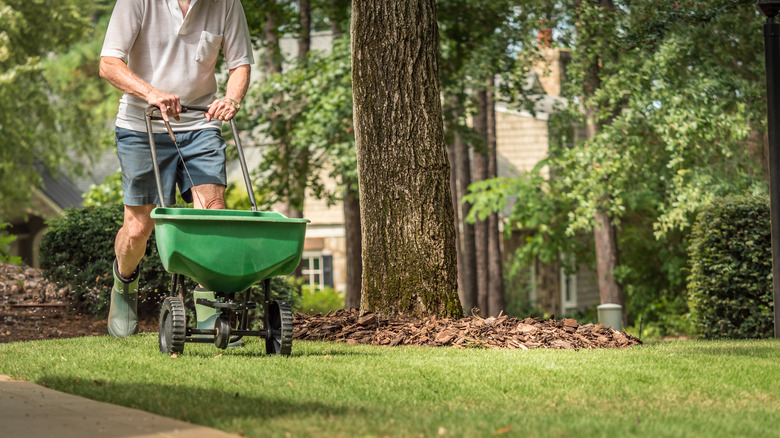If you live in an area with a wet season, experiencing a soggy lawn may be an annual phenomenon for your yard. But it doesn’t have to be! A lawn can become soggy due to several factors. Poor drainage is a common culprit, where the soil lacks proper channels for water to flow away, leading to water accumulation on the surface. Another reason is compacted soil, which exacerbates the issue of drainage by reducing permeability and preventing water from penetrating deeper layers. Combine these issues with heavy rainfall or overwatering, and the soil can become saturated beyond its capacity to absorb moisture, resulting in soggy conditions. Furthermore, inadequate sunlight and air circulation can hinder evaporation, prolonging the dampness in your yard. Nevertheless, you can mitigate these moisture issues by incorporating gypsum into your lawn.
Amending a lawn with gypsum can help mitigate soggy conditions, especially if you have particularly clay-like soil in your yard. Gypsum improves soil structure by breaking up compacted soil, allowing better water infiltration and drainage. Its calcium content facilitates flocculation, clumping soil particles together to create pore spaces for water movement. Additionally, gypsum aids in balancing soil pH, fostering healthier root growth and enhancing overall lawn resilience against waterlogging. As gypsum is a naturally occurring element, applying it to your lawn is considered all-natural, eco-friendly, and safe. By addressing soil compaction and enhancing drainage, gypsum application helps maintain optimal moisture levels and prevents the lawn from becoming soggy.
How to add gypsum to your lawn

If you’re ready to banish your waterlogged lawn for good, head to your local hardware store to pick up a bag of lawn-ready gypsum. Before starting, assess the current condition of your lawn’s soil. Look for signs of poor drainage, such as standing water after rainfall or irrigation, and compacted soil, which can hinder water infiltration. Identifying these issues will help determine the extent of gypsum application required. Once you’ve assessed the soil, choose the appropriate gypsum product for your lawn. Gypsum comes in various forms, including granules, pellets, or powder. Consider factors such as ease of application and coverage when selecting the product. It’s essential to choose a high-quality gypsum product to ensure effective soil amendment.
Before applying gypsum, prepare the lawn by mowing it to a suitable height and removing any debris or thatch that may prevent gypsum from reaching the soil. Then, spread the gypsum evenly across the lawn using a broadcast spreader or hand-held spreader. Aim for uniform coverage to ensure consistent soil amendment. After spreading the gypsum, lightly water the lawn to help activate the gypsum and facilitate its incorporation into the soil. Avoid overwatering, as excessive moisture can exacerbate soggy conditions. Allow the gypsum to penetrate the soil for a few days before resuming regular watering practices.
Monitor your lawn’s condition regularly after applying gypsum. Over time, you should notice improvements in soil structure and drainage, leading to reduced sogginess. Repeat the process as necessary.
Cautions for using gypsum
If you’re considering adding gypsum to your lawn, you should be aware of several cautions and potential dangers. While gypsum is generally regarded as safe for use in lawns, it’s crucial to follow recommended application rates. Overapplication can lead to nutrient imbalances or other soil issues, which may negatively impact plant growth and health. Therefore, it’s essential to carefully read and follow the instructions provided by the manufacturer regarding the appropriate amount of gypsum to apply based on your lawn’s size and soil condition.
Secondly, adding gypsum to severely compacted soil may not fully address underlying soil compaction issues. While gypsum can help improve soil structure, it may not be sufficient on its own to remedy severe compaction problems. Homeowners with compacted soil may need to consider additional soil improvement measures, such as core aeration or mechanical soil loosening, in conjunction with gypsum application to achieve optimal results.
Finally, it’s important to be mindful of your lawn and surrounding vegetation’s specific soil pH requirements when applying gypsum. Gypsum can affect soil pH, so it’s essential to conduct a soil test beforehand to determine whether gypsum application is suitable for your lawn. If your lawn requires a specific pH range for optimal plant growth, consult with a soil testing service or agricultural extension office to ensure that gypsum application won’t disrupt the pH balance of your soil. On that note, choose high-quality gypsum from reputable sources to avoid introducing impurities or contaminants to your lawn.
